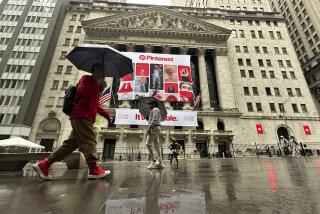Bond Rates Seen Headed Lower--With Confusion
In the hunt for a decent yield, things are getting curiouser and curiouser.
Take the Treasury bond market, for example. It resembled something right out of Aliceâs Wonderland last week, a virtual Looking-Glass Land where everything is reversed:
* New three-year and 10-year notes sold by the Treasury were snubbed by many investors. That was a shock, because bonds of those relatively short maturities have been wildly popular all year.
* In contrast, buyers couldnât get enough of the Treasuryâs new 30-year bonds, which usually are a very tough sell because they mature so far in the future.
Hereâs how it all shook out: The three-year notes yielded 6%, the 10-year notes 7.53% and the 30-year bonds 8%. And right after the 30-year bond sale, demand mushroomed so quickly for that bond that its yield fell to 7.87% by Friday.
âBond dealers told us they were running out of order formsâ for the 30-year issue, said Patricia Zlotin, who oversees government bond investing for Massachusetts Financial Services mutual funds in Boston. âIt was a feeding frenzy.â
One way to explain the Treasury sale is that investors have decided interest rates will plunge further in 1992 and beyond, because of the weak economy. Thus, buyers wanted to lock in the highest yield they could find--8% for 30 years.
If that kind of conviction were in fact gripping bond buyers, all investors would be affected. Savers, for example, would want to run right out and lock up the longest-term bank CD they could find.
But some bond experts are cautioning against reading too much into the 30-year bond sale. Long-term interest rates may indeed come down some more in 1992, but itâs going to be a slow, erratic process, not some big blowout overnight. So if youâve got money to invest, take your time.
Then what fueled the 30-year bond mania? Jim Hodapp, vice president of government securities at brokerage A. G. Edwards & Sons Inc. in St. Louis, says psychology and technical trading games had much to do with it:
* New rules governing how big investors may bid on Treasury securities caused confusion and hesitation in the three-year and 10-year note sales on Tuesday and Wednesday, causing interest rates to tick higher.
* Largely because the three-year and 10-year note sales went so poorly, Hodapp says, âeverybody thought the 30-year sale was going to be miserable too.â So instead of bidding for the 30-year bonds Thursday, many traders âshortedâ them: They sold bonds that they didnât even own, figuring that they could buy them at a higher yield right after the auction and thus fill those short-sale orders at a profit.
* Once the 30-year bond auction got under way, it became apparent that all of those short-sellers had underestimated demand. So the âshortsâ suddenly rushed in to buy the bonds to cover their positions. As more buyers poured into the market, yields plunged--just the opposite of what the shorts had bet.
These trading strategies arenât unusual in stocks or bonds. But the fact that so many traders were trying to play this game in 30-year bonds last week is a measure of the level of desperation in the marketplace. Interest rates have come down so much over the past year that investors are using any ploy they can to boost their returns. Yet such ploys often backfire.
Why canât investors just put their money in bonds today and be happy? Because everyoneâs afraid that the interest rate slide is over. Nobody wants to get caught locking up their money for any period of time if rates are going to rise in 1992.
History suggests thatâs a logical concern: For nearly 20 years now, 7.5% has been the âfloorâ yield for 30-year Treasury bonds, which act as a benchmark for many other interest rates. Whenever the yield has gotten that low over the years, the next move inevitably was up.
So at 7.87% today, the 30-year bond yield seems more likely to be near its low than on the verge of another steep plunge, most people figure. When the economy recovers next year, interest rates are sure to rise--right?
Professional investors such as Zlotin and Hodapp subscribe to that conventional wisdom. But they also admit that what they see happening in the real world around them suggests that any economic recovery will be feeble in 1992.
Hodapp, for example, says that of 40 people who work on his trading desk, âI canât think of one whoâs bought a new car over the past year.â Neither do any of them talk about buying a car next year, he says. Thereâs no pent-up desire to spend on such big-ticket items.
Zlotin recalls a recent trip to her dry cleaner in Boston, where she discovered that the owner had actually cut prices -- a first, as far as she can recall. âThings like that are happening,â she says in awe.
Point is, if consumers are going to take years to rebuild their shattered finances after the go-go 1980s, spending and thus inflation could remain low for a long, long time. That would keep demand for money low. And that could mean the 7.5% long-term T-bond yield floor may soon be history.
The process of getting interest rates down from here, though, will probably be agonizingly slow. A lot of minds still have to be changed.
But thatâs OK; it leaves more time for individual investors to slowly put their cash to work in longer-term investments, a little each month over the next year--rather than in one big plunge through Wall Streetâs crazy Looking Glass.
Lower Than We Think: Thatâs what interest rates already may be in the United States--at least, relative to inflation.
The accompanying chart shows ârealâ yields on 10-year government bonds in eight countries. The real yield on a bond is the stated yield minus the countryâs annualized inflation rate. It simply tells you how much youâre truly earning, after inflation takes its toll.
In the U.S., that real yield is now about 3.7%, subtracting an inflation rate of 3.8% from a bond yield of about 7.5%, according to bond-fund manager Patricia Zlotin at Massachusetts Financial Services.
In contrast, real yields are far higher in most other countries--which means that investors in those countries have a much stronger reason to buy bonds than we do, theoretically. Check out that 7% real yield in New Zealand, or the 6.1% real yield in France.
Does this suggest American investors arenât being adequately paid to own bonds now? Not necessarily. One reason our bond yields are lower versus inflation is because the Treasury bond market is so large and liquid, Zlotin says. Itâs easy to buy and sell quickly.
That isnât the case in a tiny country such as New Zealand, so investors there traditionally keep bond yields high to compensate for the risk of getting stuck.
Still, the relatively low real yields on U.S. bonds suggest that there isnât a lot of margin for error now: Inflation had better decline substantially next year to keep our bonds looking good.
If inflation should rise even slightly, U.S. bond yields could rocket. Thatâs another good reason to go slow with bond investments, buying in installments rather than all at once now.
Red-Hot Hong Kong: Speaking of inflation, look what itâs done for the Hong Kong stock market: The Hang Seng stock index has soared from 3,988.60 on Oct. 28 to a record 4,236.64 on Friday, a 6% gain in nine days--all because inflation seems certain to remain a problem .
Huh? Normally, youâd expect bad inflation news to hurt stocks. Not in Hong Kong. Christian Wignall, Asian-stock investor for the G. T. Global mutual funds in San Francisco, explains:
In October, the Hong Kong government began to make noises about dampening inflation, which has been running near a 12% annual rate. A strong economy, large wage increases and real estate speculation have been fueling that high rate.
Some investors had feared that the government would try to impose new taxes or other strong measures to slow the economy. But when the anti-inflation program was finally announced early last week, Wignall says, it turned out to be virtually toothless--sparking a huge rally in Hong Kong stocks.
To Hong Kong investors, Wignall says, âfear of government meddling is more of a worry than inflation. . . . The stock market there definitely doesnât want inflation controls.â
Besides, Wignall says, thereâs a powerful argument that the salary gains pushing inflation higher represent a âstructural adjustment to wage levelsâ that will in the long run help Hong Kong.
Big wage increases in the services sector, for example, are a natural side effect of Hong Kongâs rapid development as a services capital for Chinaâs booming next-door province, the manufacturing center of Guangdong. âTwice as many goods now are shipped through Hong Kong as are made in Hong Kong,â Wignall says.
In addition, he notes that concern over Chinaâs takeover of Hong Kong in 1997 is driving many Hong Kong professionals to emigrate--so their employers are trying to stem the tide with big salary hikes.
Like the Hong Hong market itself, Wignall is bullish on the city-stateâs future. Though the stocks arenât dirt-cheap anymore, neither are they overvalued, he says. So heâs still âvery overweightedâ with Hong Kong stocks in his portfolios, including the G. T. Pacific stock fund, which has 15% of its assets in Hong Kong issues.
What Bonds Really Pay
When you measure the interest yield on a CD or bond, you should study more than the nominal yield. Look at the yield after deducting the inflation rate. By that measure of ârealâ return, U.S. bonds now are paying less than bonds of almost any other country. Here are real yields on 10-year government bonds in eight nations.
Real (after inflation) bond yields:
Japan: 3.2%
U.S.: 3.7%
Germany: 5.0%
Canada: 5.3%
Spain: 5.9%
France: 6.1%
Australia: 6.7%
New Zealand: 7.0%
Source: Massachusetts Financial Services
What Bonds Really Pay, Los Angeles Times
More to Read
Inside the business of entertainment
The Wide Shot brings you news, analysis and insights on everything from streaming wars to production â and what it all means for the future.
You may occasionally receive promotional content from the Los Angeles Times.










